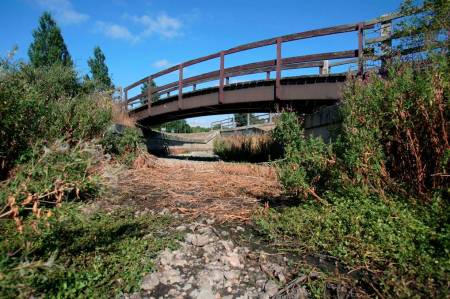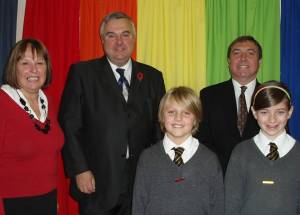I know constituents are interested in the Benington wind farm issue and this my statement for the forthcoming Inquiry:
STATEMENT OF OLIVER HEALD MP
I am making this statement in opposition to the proposal to site wind turbines on the land of the Bott family at Benington, Hertfordshire. The hill on which the turbines would be sited looks down on the historic village of Watton-at-Stone. The site for the turbines is substantially in the Green Belt.
I have been a Member of Parliament since 1992 and since 1997 my Parliamentary Constituency of North East Hertfordshire has included the village and parish of Watton-at-Stone.
Watton-at-Stone is a thriving village with shops, public houses, a school, a railway station and a church. It is in the heart of the Green Belt. It has about 2000 residents, 1700 of whom are adults. It is about 30 miles from Central London and is 6 miles from Stevenage and a similar distance from Hertford. It is in the southern part of the valley of the River Beane, a well-known chalk stream which feeds into the River Lea at Hertford. Residents of Watton-at-Stone are rightly proud of their village history, which goes back to the Domesday Book. Many local buildings are listed Grade 2 including Gregory’s Farm, the Church and the Waggon and Horses’ public house. Nearby Woodhall Park is a Grade 1 listed Mansion House. The High Street is full of Tudor cottages.
My Constituency also includes the towns of Letchworth Garden City, Baldock, Royston and Buntingford, as well as many villages and it extends to the south as far as the Five Greens south of Tewin. It covers 181 square miles. Apart from the Garden City, it is made up of communities with a long history and which have developed from medieval settlements among chalky hills and streams and connected by a tracery of small lanes, which complement the more substantial roads such as the A10, A505, A507, A602 and the A414. My Constituency is neighboured by the Stevenage Constituency, which currently includes Benington, although Benington will come into the North East Hertfordshire Constituency at the next General Election.
Hertfordshire is one of the most heavily populated counties and is very built-up, but the Beane Valley is in the precious unspoilt part. It does not even have pylons. There is a Society dedicated to preserving and improving the condition of the River. Many people from other more urban parts of the County visit this area to enjoy the countryside. It is often described as part of the lungs of the County. The southern part of the valley near Watton-at-Stone is more wooded and hilly and has a smaller scale to it than the more open middle and northern parts.
A group of residents of Watton-at-Stone came to my surgery in the Community Centre to object to the idea of wind turbines being sited on the hill above the village. The Chairman of the Watton Parish Council and District Councillor, Councillor Nigel Poulton suggested that I visit the exhibition of the plans at Benington Village Hall. We went together and I met many people from my Constituency who were adamantly opposed to the proposal. I also had the chance to talk to Mr Andrew Bott and to see the exhibition including projections of how the turbines would impact visually on the area. I was shocked that the turbines were so large, being as high as the London Eye and placed in such an intrusive position that they would be clearly visible from the historic buildings of Watton and totally out of scale with the valley of a small chalk river and the surrounding small hills, hedges and copses.
I also visited the exhibition held at a later date at Watton Community Centre of the book of plans submitted in support of the application. Councillor Poulton and I have also visited Mr and Mrs Bott to discuss the plans and we spoke fully and frankly with them about their scheme. I also attended a rally and march against the proposals held in Benington by “Stop Benington Wind Farm” and I wrote to East Hertfordshire District Council objecting to the application. I have seen barrage balloons positioned by objectors to show the great height of the turbines.
At least a hundred representations have been made to me against this application by concerned local residents. Councillor Poulton has told me that hundreds of residents have contacted him to say how much they oppose this scheme.
The main objections made to me were: first, that these turbines would have a badly damaging visual impact on this particular landscape and the historic village setting and secondly, that they were inappropriate in the Green Belt. There were also objections about the proposals for heavy construction traffic through the centre of the village of Watton-at-Stone, which would involve changing the road configuration and causing considerable inconvenience.
The three main concerns about the visual impact were: first, that the size of the turbines would overpower the small scale of the landscape of the southern Beane Valley and spoil the visual amenity which it provides to local residents and visitors. Secondly, that such a radical change to this part of the Beane Valley would destroy its character as a gently evolved rural landscape. Thirdly, historic Watton-at-Stone would be spoiled by having industrial structures on its skyline. The view from important historical buildings would be harmed. I am told by Councillor Poulton that there is fear that business would be affected by a reduction in visitors to the village and that it would become a less attractive area for horse riding and horse related businesses, because riders are concerned that horses would be frightened by the noise and movement of the turbines. This is an area with a very high level of horse riding with many horse related businesses, pony paddocks, livery and riding establishments, much used by urban dwellers in the nearby Hertfordshire towns. This is documented in paragraph 4.12 of the District Local Plan.
I understand that the fundamental aim of Green Belt policy is to keep land permanently open and to shape patterns of urban development to ensure that development occurs in locations allocated in development plans. They protect the countryside, be it in agricultural, forestry or other use. I believe there are five purposes of including land in Green Belts:
• to check the unrestricted sprawl of large built-up areas;
• to prevent neighbouring towns from merging into one another;
• to assist in safeguarding the countryside from encroachment;
• to preserve the setting and special character of historic towns; and
• to assist in urban regeneration, by encouraging the recycling of derelict and other urban land.
The proposed erection of wind turbines on the hill above Watton would not safeguard the countryside from encroachment, but would rather be a major industrial encroachment. It would not preserve the setting and special character of historic towns, but damage the setting and special character of the large historic village of Watton-at-Stone.
I understand that once Green Belts have been defined, the use of land in them has a positive role to play in fulfilling the following objectives:
• to provide opportunities for access to the open countryside for the urban population;
• to provide opportunities for outdoor sport and outdoor recreation near urban areas;
• to retain attractive landscapes, and enhance landscapes, near to where people live;
• to improve damaged and derelict land around towns;
• to secure nature conservation interest; and
• to retain land in agricultural, forestry and related uses.
The proposal would lead to the open countryside being less attractive to visitors from Hertfordshire towns such as Stevenage and Welwyn Garden City and thereby reduce access to the countryside for these urban dwellers. It is likely to reduce horse riding in the area as local riders are wary of the effect of the noise and movement on their animals. It interferes with an attractive landscape near Watton-at-Stone.
I understand that within the Green Belt, there is a presumption against inappropriate development. Planning Policy Statement 22: Renewable Energy (2004) mentions renewable energy development in the Green Belt:
“Policy on development in the green belt is set out in PPG2. When located in the green belt, elements of many renewable energy projects will comprise inappropriate development, which may impact on the openness of the green belt. Careful consideration will therefore need to be given to the visual impact of projects, and developers will need to demonstrate very special circumstances that clearly outweigh any harm by reason of inappropriateness and any other harm if projects are to proceed. Such very special circumstances may include the wider environmental benefits associated with increased production of energy from renewable sources.”
I do not accept that there are such very special circumstances here.
The East Hertfordshire District Council Local Plan Policy, Chapter 4: “Green Belt and the Countryside” (GBC) sets out in GBC1 that permission will not be given for inappropriate development unless very special circumstances can be demonstrated and that building will be inappropriate unless it falls within certain purposes, none of which apply to this application.
It is the policy of East Hertfordshire District Council GBC2 to maintain a rural area beyond the Green Belt in the centre and northern part of the District where inappropriate development will not be permitted. Insofar as this application relates to land outside the Green Belt, this policy applies, as does GBC3, which provides that permission will not be given save for certain limited purposes which do not apply to this application.
I also refer to GBC14 and the East Hertfordshire District Council Landscape Character Assessment Supplementary Planning Document. The Assessments for Areas 39, 70 and 71 are relevant. None of these assessments suggest that this application would be appropriate.
It would be wrong to sacrifice this most unspoilt valley in Hertfordshire to this industrial development. I oppose this planning application.





 Posted by oliverheald
Posted by oliverheald 

